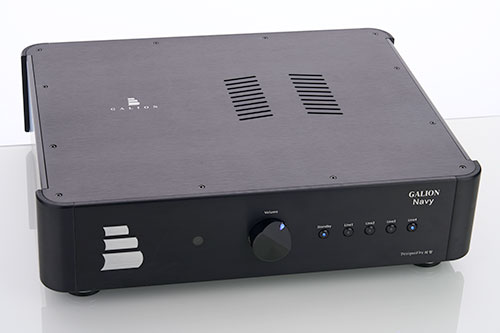Its inputs, referred to as “Enjoyment Sources,” are numbered from one to six. This isn’t due to a lack of originality but with the modular input design: Among these, three inputs offer the choice between Zeel 50-ohm BNC and RCA connections. For the latter, a six-decibel attenuation switch can also be engaged. Additionally, the preamplifier includes a standard XLR input and two customizable inputs based on customer's preferences, which can be configured as balanced, unbalanced, or MC phono inputs. The “Standard” configuration of the NHB-18NS already includes one MC input. My test unit, however, was equipped with two MC inputs, increasing its cost by 10,000 Euro to 75,000 Euro. With a two-way toggle switch on the phono input, you can not only choose between normal RIAA equalisation and one with the so-called Neumann constant, and switch on a subsonic ic filter, but also to adjust the amplification in six three-decibel steps between 57 and 72 decibels and the load impedance in six steps between 43 and 300 ohms. Even without menus with the corresponding software and a lot of processor power, the darTZeel preamplifier proves to be extremely flexible.

On the output side, the NHB-18NS also leaves you spoilt for choice: in addition to a RCA and a XLR socket, there are also three BNC connectors with 50 ohms for connecting to darTZell power amplifiers, making bi- or even tri-amping a breeze. Since Hervé Delétraz owns various Revox and Studer tape machines, he has also provided his preamplifier with a tape output, unfortunately only an unbalanced one with a RCA socket. On the other hand, the effort put into the power supply is all the greater: in the front part of the preamplifier, which is designed in a double-mono construction, under a red anodised cover with the writing ‘darTZeel – The never heard before experience’, there are batteries that are charged by an external power supply unit, which is also excellently manufactured in the characteristic company colours.

The power supply for the power amps is integrated into the very elaborately designed power amp, and it would not be an exaggeration to say that the circuits are arranged around the power supply. The enclosure of the NHB-108 is divided into four sections, two per channel. The two 300-watt toroidal transformers are located behind the front panel. The comprehensive operating instructions, with their detailed explanation of the development of the power amplifier, state that the transformers were wound on 450-watt cores to prevent them from saturating. The primary windings are electrostatically shielded from the secondary windings so that no high-frequency interference is transmitted. The transformers are mounted on a so-called ‘false’ base plate and placed on rubber dampers so that practically no vibrations are transmitted to the circuits. The 20-millimetre-thick plate with the transformers is located a short distance from the five-millimetre-thick base plate that is visible from the outside. All cables and lines are routed through the space in between, minimising electromagnetic interference.
-
Galion Audio Navy Röhrenvorverstärker
Wir haben das röhrenbestückte Vorverstärker-Flaggschiff Navy des jungen kanadischen HiFi-Unternehmens Galion Audio unter die Lupe genommen. Der Line-Vorverstärker mit vier Doppeltrioden 12AT7 (ECC81) wartet nicht nur mit hochwertigen Bauteilen auf, sondern er ist das spannende Designprodukt eines high-fidelen Überzeugungstäters. Mir sagte der Markenname Galion Audio bislang wirklich gar nichts. Das junge Unternehmen aus Québec in Kanada wurde 2020 von Thomas Tan, einem passionierten Audiophilen, YouTuber („Thomas & Stereo“) und Content Creator, gegründet. Ziel war, seine…16.12.2025 -
Eversolo DAC-Z10
Meine beiden D/A-Wandler, der DAVE im Arbeits- und der HUGO TT2 im Wohnzimmer, werden serienmäßig von Schaltnetzteilen gespeist. Bei letzterem kommt seit einiger Zeit ein Ferrum Hypsos, bei Chord Electronics Topmodell ein lineares Dreifach-Netzteil zum Einsatz. Ein solches versorgt auch den Eversolo DAC-Z10 – zum Preis von 2.000 Euro. Und nein, es sind keine drei ausgelagerten Stromversorgungen, für die der genannte Preis gilt. Dafür bekommt man das vollständige Topmodell unter Eversolos DACs. Es ist schon…09.12.2025 -
Raidho X2.6 Standlautsprecher
Mit Lautsprechern von Raidho haben wir uns bei Hifistatement schon öfter beschäftigt. Im Fokus standen dabei die Kompaktlautsprecher TD1.2 aus der TD-Serie sowie X1t und X1.6. aus der X-Serie. Diesmal haben wir den Standlautsprecher X2.6 zu Gast, das aktuell größte Modell der X-Serie. Raidho verspricht, mit der X-Serie besonders viel Leistung – sprich Klangqualität – für den aufgerufenen Preis zu bieten. Wobei, „billige“ Lautsprecher – ganz gleich nach welchem Maßstab - hat Raidho noch nie…02.12.2025 -
Canor Virtus A3
Zur diesjährigen HighEnd stellte Canor den Virtus A3 Hybrid-Vollverstärker vor. Der lockt mit einem integrierten Digital-Analog-Wandler und einer diskret aufgebauten Phono-Vorstufe für MM- und MC-Tonabnehmer. Sowohl seine Technik als auch die Ausstattung bieten Ungewöhnliches. Vor allem aber soll er klanglich beeindrucken. Das slowakische Entwickler-Team konnte mich bereits vor einem Jahr überzeugen: Der Vollverstärker Virtus I2 aus der Premium Line musizierte in meinem Hörraum wie keiner zuvor in dieser Preisklasse. Der war ein gestandener Röhren-Vollverstärker. Auch…28.11.2025 -
Dan D’Agostino Progression S350
Dan D’Agostino ist eine Legende im Verstärkerbau. Er folgte wohl nie einer Mode, sondern vertraut bei allen Entwicklungen seinem Gehör und seiner Leidenschaft für den guten Klang. Mehr als 50 Jahre baut er nun schon Verstärker, immer mit dem Ziel, das „Wesen der Musik hörbar zu machen“. Erfüllt auch der S350 diese hoch gesteckten Ambitionen? Die Progression S350 ist die kleinste Stereoendstufe im Gesamtprogramm. Optisch trägt sie alle charakteristischen Merkmale einer echten D’Agostino. Angefangen mit…25.11.2025 -
iFi Silent Power USB iPurifier Pro & Pulsar USB
Ohne iFis iDefender+ würde das PC-Audio-Setup in meinem Arbeitszimmer überhaupt nicht störungsfrei funktionieren. Dementsprechend ist es für mich eines der besten Tools im Bereich Computer-Audio. Der iPurifier Pro vereint seine Fähigkeiten mit denen eines iSilencer+ und noch mehr Features in einem Gehäuse. Außerdem teste ich das Pulsar USB-Kabel. iFi ist seit Jahren eine Konstante für hochqualitative Audio-Produkte zu fairen Preisen. Zuletzt wurde die Sparte für Stromversorgung, Kabel und Signal-Verbesserer unter SilentPower zusammengefasst. Noch bevor wir…21.11.2025
© 2025 | HIFISTATEMENT | netmagazine | Alle Rechte vorbehalten | Impressum | Datenschutz

























 |
|















































































